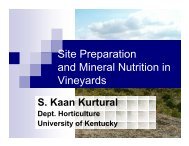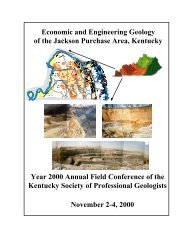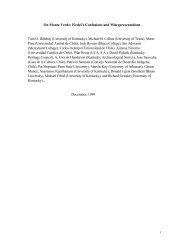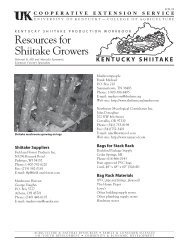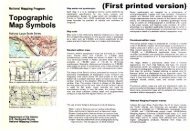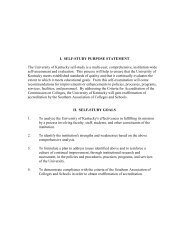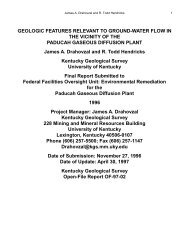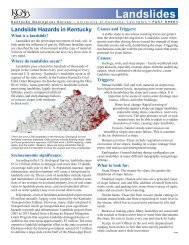Observed Seismicity - University of Kentucky
Observed Seismicity - University of Kentucky
Observed Seismicity - University of Kentucky
You also want an ePaper? Increase the reach of your titles
YUMPU automatically turns print PDFs into web optimized ePapers that Google loves.
14<br />
Appendix A<br />
installed seismic stations in western <strong>Kentucky</strong><br />
have also been upgraded. These new<br />
and upgraded seismic stations, in combination<br />
with existing seismic networks, will<br />
provide better information on earthquake<br />
activity in the region and help reduce the<br />
uncertainty about the northern boundary <strong>of</strong><br />
the New Madrid Seismic Zone. Because <strong>of</strong><br />
the time-dependent nature <strong>of</strong> earthquake<br />
activity, a minimum <strong>of</strong> 2 years <strong>of</strong> observation<br />
is required.<br />
A sensitivity analysis was conducted,<br />
based on the data sets used by the U.S.<br />
Geological Survey. This analysis showed that<br />
the seismic hazard in western <strong>Kentucky</strong> is<br />
dominated by the earthquakes from the New<br />
Madrid Seismic Zone. The analysis also<br />
showed that a large uncertainty was inherent<br />
in the ground-motion hazard for western<br />
<strong>Kentucky</strong>: the ground motion for western<br />
<strong>Kentucky</strong>, particularly the Jackson Purchase<br />
area, has been overpredicted by as much as a<br />
factor <strong>of</strong> two. A full-scale study is needed to<br />
provide a credible and defensible seismic<br />
hazard assessment for western <strong>Kentucky</strong>.<br />
Anticipated time for the full-scale study is 18<br />
to 24 months.<br />
The seismic issue in western <strong>Kentucky</strong><br />
also requires intensive communications with<br />
related government and nongovernment<br />
agencies. The principal investigators have<br />
actively communicated with personnel from<br />
Federal agencies, including the U.S. Geological<br />
Survey and Nuclear Regulatory Commission,<br />
and other national experts on seismic<br />
hazard assessment in the central United<br />
States, western <strong>Kentucky</strong> in particular. A<br />
workshop was held on November 18, 2002,<br />
in Lexington to discuss seismic hazards, risk,<br />
and design maps in the central United States,<br />
especially western <strong>Kentucky</strong>. It was attended<br />
by 110 geologists, seismologists, engineers,<br />
emergency managers, and others from the<br />
related Federal and State agencies. Three key<br />
problems were identified at the workshop:<br />
1. The probabilistic ground-motion hazard<br />
with 2 percent probability <strong>of</strong> being exceeded<br />
in 50 years for the New Madrid<br />
region (including western <strong>Kentucky</strong>) is<br />
overly conservative.<br />
2. There are many inconsistencies in the<br />
NEHRP 97 seismic design maps. These<br />
inconsistencies have resulted in very high<br />
seismic design for western <strong>Kentucky</strong>.<br />
3. There is lack <strong>of</strong> communication between<br />
the map developers and the users in the<br />
central United States.



